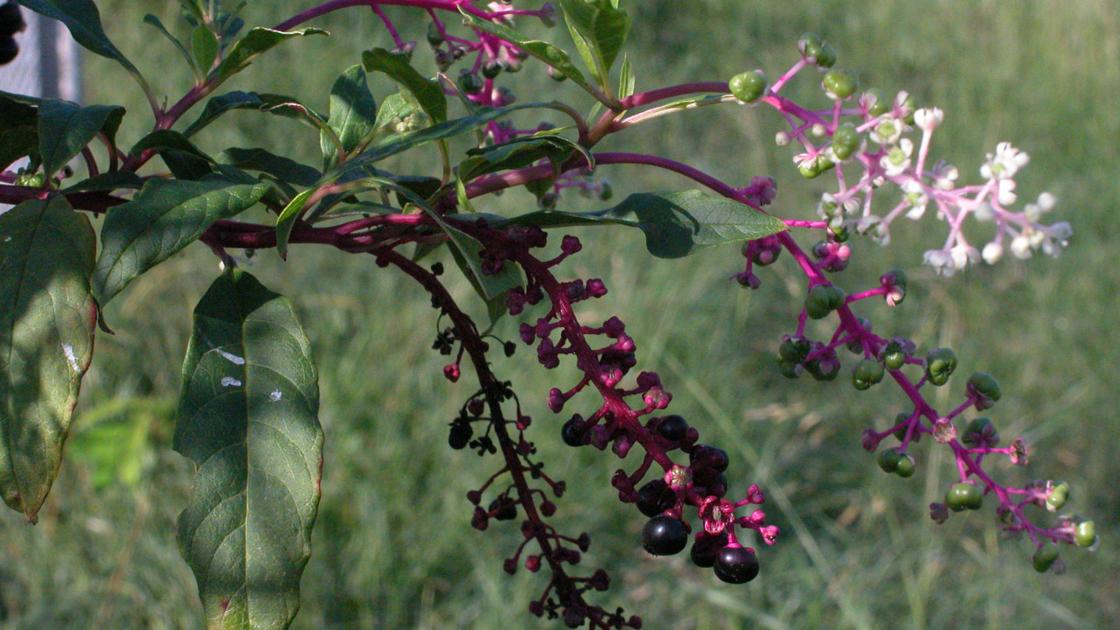
“(Annie)’d go out in the evening and pick a mess of it …
Carry it home and cook it for supper,
‘Cause that’s about all they had to eat.”
— lyrics by Tony Joe White
Of course, Annie would only collect this stuff in the spring, as the plants were just coming up. The young, tender leaves, boiled, have been used for a long time as a pot-herb (love that term!), which means that cooking is involved — in this case, a lot of cooking, as they must never be eaten raw.
The plant’s parts tend to be poisonous, especially late in the growing season, as in now.
What an odd native American it is! Nearly all of its relatives are tropical, in both South America and in Africa. Some even attain “big tree” size.
Our plant, though, is definitely an herb, a perennial, coming back year after year (if given the opportunity) from massive root-crowns.
It grows up quickly, making smooth stems and leaves. The stems are rather fragile, hollow and pithy, and easily broken or knocked down.
In the summer, flowers are produced on racemes, which appear one at a time opposite a stem leaf. Twenty or thirty flowers will be produced on the raceme. This is one of those plants whose flowers have no petals. There are instead five sepals, white or pink, which appear to be petals and thus are said to be “petaloid.”
Many stamens are included within each flower, as are a number of pistils, all arranged in a ring. These beautiful plants get to be 5 or 6 feet tall (sometimes taller). Late in the summer, the plants’ stems commonly become bright red, especially if growing in the sun.
The young berries, first green and hard, swell, becoming a lustrous purple-black, marvelously shiny. The mature berries are full of juice and a number of seeds. The juice has been used as a sort of dye for fabrics, or even “war paint” for young renegades, but be warned that this juice really can stain your clothing (or skin)!
Various bird species don’t mind eating these succulent fruits, and you often can see the artful purplish windshield trails and splotches provided by our avian friends.
This common plant is a weed, generally, most often found in sunny places that have been recently disturbed. Roadsides, windrows and forest tip-ups are frequent sites. It is fairly common throughout the eastern United States and eastern Canada. I’ve had some growing in my backyard here in Columbia for several years now.
The proper recipes for producing a mess of greens from this plant involve boiling the young leaves two or three times, changing the water on each occasion. You actually can purchase this delicacy canned or find various recipes for its preparation, picked yourself.
Most of these recipes involve a considerable amount of fatback or ham hocks, tomatoes and some hot peppers. Maybe some chopped onions.
(Answer: “Pokeweed,” “Goozleberry,” Phytolacca americana)
John Nelson is the retired curator of the A.C. Moore Herbarium at the University of South Carolina, in the Department of Biological Sciences, Columbia SC 29208. As a public service, the Herbarium offers free plant identifications. For more information, visit www.herbarium.org or email johnbnelson@sc.rr.com.
The Link LonkAugust 13, 2020 at 12:10AM
https://ift.tt/2CtTOOa
Common perennial herb grows best in sunny spots - Rocky Mount Telegram
https://ift.tt/3eCf9lu
Herb
No comments:
Post a Comment